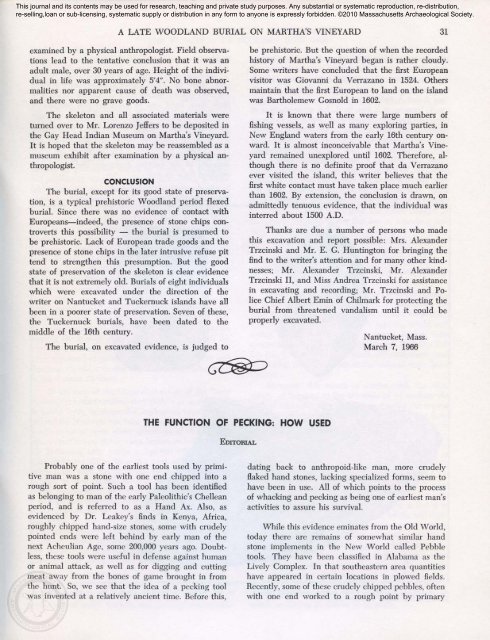Aboriginal Grinding Equipment, 31(1-2)
Aboriginal Grinding Equipment, 31(1-2)
Aboriginal Grinding Equipment, 31(1-2)
You also want an ePaper? Increase the reach of your titles
YUMPU automatically turns print PDFs into web optimized ePapers that Google loves.
This journal and its contents may be used for research, teaching and private study purposes. Any substantial or systematic reproduction, re-distribution,<br />
re-selling,loan or sub-licensing, systematic supply or distribution in any form to anyone is expressly forbidden. ©2010 Massachusetts Archaeological Society.<br />
A LATE WOODLAND BURIAL ON MARTHA'S VINEYARD <strong>31</strong><br />
examined by a physical anthropologist. Field observations<br />
lead to the tentative conclusion that it was an<br />
adult male, over 30 years of age. Height of the individual<br />
in life was approximately 5'4". No bone abnormalities<br />
nor apparent cause of death was observed,<br />
and there were no grave goods.<br />
The skeleton and all associated materials were<br />
turned over to Mr. Lorenzo Jeffers to be deposited in<br />
the Gay Head Indian Museum on Martha's Vineyard.<br />
It is hoped that the skeleton may be reassembled as a<br />
museum exhibit after examination by a physical anthropologist.<br />
CONCLUSION<br />
The burial, except for its good state of preservation,<br />
is a typical prehistoric Woodland period flexed<br />
burial. Since there was no evidence of contact with<br />
Europeans-indeed, the presence of stone chips controverts<br />
this possibility - the burial is presumed to<br />
be prehistoric. Lack of European trade goods and the<br />
presence of stone chips in the later intrusive refuse pit<br />
tend to strengthen this presumption. But the good<br />
state of preservation of the skeleton is clear evidence<br />
that it is not extremely old. Burials of eight individuals<br />
which were excavated under the direction of the<br />
writer on Nantucket and Tuckernuck islands have all<br />
been in a poorer state of preservation. Seven of these,<br />
the Tuckernuck burials, have been dated to the<br />
middle of the 16th century.<br />
The burial, on excavated evidence, is judged to<br />
Probably one of the earliest tools used by primitive<br />
man was a stone with one end chipped into a<br />
rough sort of point. Such a tool has been identified<br />
as belonging to man of the early Paleolithic's Chellean<br />
period, and is referred to as a Hand Ax. Also, as<br />
evidenced by Dr. Leakey's finds in Kenya, Africa,<br />
roughly chipped hand-size stones, some with crudely<br />
pointed ends were left behind by early man of the<br />
next Acheulian Age, some 200,000 years ago. Doubtless,<br />
these tools were useful in defense against human<br />
or animal attack, as well as for digging and cutting<br />
meat away from the bones of game brought in from<br />
the hunt. So, we see that the idea of a pecking tool<br />
was invented at a relatively ancient time. Before this,<br />
THE FUNCTION OF PECKING: HOW USED<br />
EDITORIAL<br />
be prehistoric. But the question of when the recorded<br />
history of Martha's Vineyard began is rather cloudy.<br />
Some writers have concluded that the first European<br />
visitor was Giovanni da Verrazano in 1524. Others<br />
maintain that the first European to land on the island<br />
was Bartholemew Gosnold in 1602.<br />
It is known that there were large numbers of<br />
fishing vessels, as well as many exploring parties, in<br />
New England waters from the early 16th century onward.<br />
It is almost inconceivable that Martha's Vineyard<br />
remained unexplored until 1602. Therefore, although<br />
there is no definite proof that da Verrazano<br />
ever visited the island, this writer believes that the<br />
first white contact must have taken place much earlier<br />
than 1602. By extension, the conclusion is drawn, on<br />
admittedly tenuous evidence, that the individual was<br />
interred about 1500 A.D.<br />
Thanks are due a number of persons who made<br />
this excavation and report possible: Mrs. Alexander<br />
Trzcinski and Mr. E. G. Huntington for bringing the<br />
find to the writer's attention and for many other kindnesses;<br />
Mr. Alexander Trzcinski, Mr. Alexander<br />
Trzcinski II, and Miss Andrea Trzcinski for assistance<br />
in excavating and recording; Mr. Trzcinski and Police<br />
Chief Albert Emin of Chilmark for protecting the<br />
burial from threatened vandalism until it could be<br />
properly excavated.<br />
Nantucket, Mass.<br />
March 7, 1966<br />
dating back to anthropoid-like man, more crudely<br />
:Baked hand stones, lacking specialized forms, seem to<br />
have been in use. All of which points to the process<br />
of whacking and pecking as being one of earliest man's<br />
activities to assure his survival.<br />
While this evidence eminates from the Old World,<br />
today there are remains of somewhat similar hand<br />
stone implements in the New World called Pebble<br />
tools. They have been classified in Alabama as the<br />
Lively Complex. In that southeastern area quantities<br />
have appeared in certain locations in plowed fields.<br />
Recently, some of these crudely chipped pebbles, often<br />
with one end worked to a rough point by primary

















